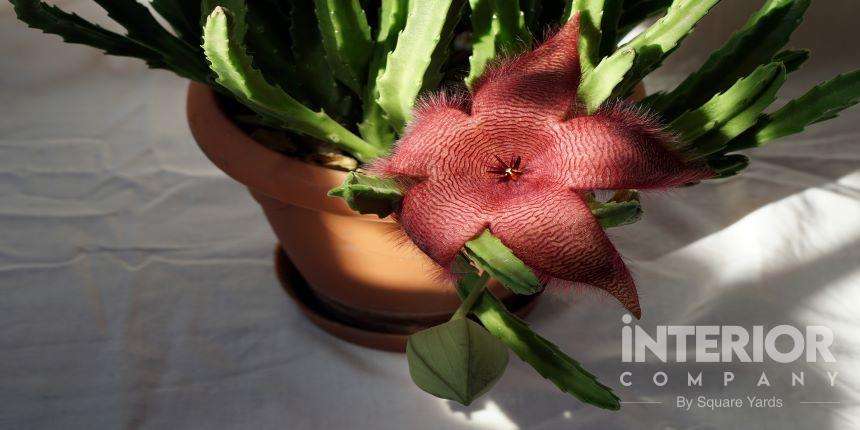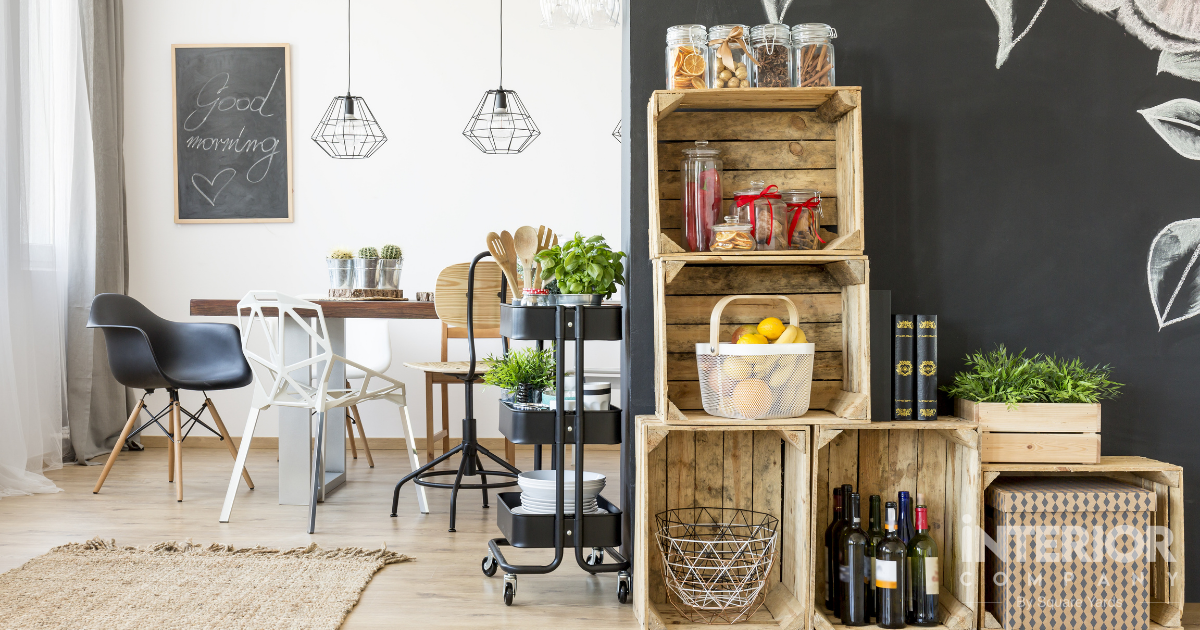- Kitchens
- Design Ideas
- Cities
- Trends
- Guides
- Price Calculators
- Our PortfolioNEW
- More
- Home
- Trends
- Furniture And Decor
- Indoor Plants
- Stapelia Plants Indp
Stapelia Plants - A Decoration and Care Guide for Your Home
Commonly known as the ‘starfish plant’ or ‘starfish cactus’ due to the starfish-like flowers it produces, Stapelia is a famous African plant. Stapelia is one of the most famous exotic succulent plants which come from the tropical regions of South Africa. They are also known as the carrion plant because they smell like rotten flesh. Yes, that sounds disgusting but the beauty of it beats everything. The blooms of the starfish flower are beautiful and should be on your windowsill.
Table of Content
Stapelia is a unique plant and is usually a foot long. They come in bright colours like red, pink, and orange so they will add a touch of pizzazz to your interiors. Their bodies have hair over them so keep that in mind before you buy them.
Stapelia varieties

Comprising a staggering 50 species of plants, the succulent Stapelia comes from Southern Africa. The Stapelia plant grows well and is commonly used as an indoor window plant. Some of the varieties of the Stapelia plant are:
- Stapelia gigantea: Received the Award of Garden Merit, Stapelia gigantea produces 5 petalled flowers. The beautiful yellow petals are marked by various proportions. This is one of the most popular house plants.
- Stapelia grandiflora: The colour of this stapelia plant ranges from red to yellow. The buds come from the base of the stems. These plants are native to South Africa.
- Stapelia hirsuta: Having very hairy flowers and quadrangle stems, Stapelia hirsuta can grow up to about eight inches. They belong to the Cape Province of South Africa and are very flashy-looking.
- Stapelia leendertziae: the long stems of this Stapelia plant are green and dull. These plants can bear a minimum amount of frost. They belong to the mountain land of Swaziland.
- Stapelia lepida: The stems of this succulent plant are toothed and light green in colour. It has five petals and the colour is a beautiful combination of brown and yellow. It belongs to the Eastern Cape of South Africa.
- Stapelia mutabilis: Originated in the Imperial Garden of Vienna, this succulent is still unknown as a wild plant. This yellow and red lined Stapelia plant is a hybrid.
- Stapelia variegata: A combination of yellow and purplish-brown patterned flowers, Stapelia variegata grows as long as six inches high. The blossoms are also 2-3 inches wide.
How to care for and grow Stapelia flower
Being a succulent plant, Stapelia is very easy to grow and care for. They usually need a little attention during the summer and spring months but they do not require much care in winters. These Stapelia plants can easily survive outdoors in the months of summer. But, in the winters you need to keep them indoors in a room that has a temperature of above 50 degrees Fahrenheit.
Keep these few pointers in mind to take proper care of your starfish flower.
- Whether you are placing a Stapelia indoors or outdoors, you need to keep them in indirect and bright light because this is what they thrive on. Do not keep them under direct sunlight as it can damage the plant.
- The Stapelia plant does not require any kind of fertilizer.
- Always wait for the soil to dry out completely before you water it again. Water the plant in abundance during the summers. They require very little water during winter.
- Basic to the succulent plants, the Stapelia plant too likes well-drained and airy soil for growing. Since you will not be putting any fertilizer in the plant you need to make sure that the soil contains enough organic matter. Ensure that it is not too acidic.
- The best time to repot or transplant the Stapelia plant is during the springtime. The Stapelia requires an open and low pot so that it can spread properly. Do put pebbles etc in the pot so that the drainage is good.
- Stapelia plants do not require much grooming. Just remove the flowers when they are not blooming anymore. Cut down the unsightly and dead stems.
Bloom time of Stapelia
It only takes your Stapelia to produce a flower bud and then it will take no time opening up. It can take a couple of weeks for a Stapelia plant to grow a bud and then produce a full flower. So, the Stapelia flowers are slow bloomers. They take their sweet time before they show up.
Once the flower shows up it stays for almost a week. Day two and three of the starfish flower are its prime days. The flowering star-shaped blooms are showy and glamorous.
What does Stapelia smell like

Often called the 'corpse flower', Stapelia flowers produce a smell like that of rotten flesh. It releases a peculiar smell to attract pollinators. The insects lay their eggs on the flowers and then spread pollen from one flower to another. But, it does not always smell like that. Also, a Stapelia flower does not smell up an entire room, you can only smell the flower when you take a whiff of it.
Stapelia plant cultivation
Growing a Stapelia flower is quite hassle-free and does not require much effort to cultivate. One of its species, Stapelia variegata does demand extra care. With hairy stems and unusual flowers, this Stapelia plant requires careful watering when it is growing. It should be completely deprived of water during the months of winter. The plants should be kept dry during winters and the water should be completely withdrawn. An incubator or a heating medium could help the plant survive harsh winter conditions. They also prefer a little shade rather than the bright direct sunlight.
For the more delicate Stapelia species clay pots are recommended. Only mineral compost could help the plant prevent a fungal attack. And the stapelia plants are often attacked on the stems by insects which can lead to the plant getting destroyed.
How to tackle pests and other problems
- Do not overwater the plant as it will lead to the rotting of the stem. Your plant will die completely. If you notice some areas of the plant that are rotting, then you can save the plant by cutting out those rotted areas.
- If you do not water your Stapelia plant enough then it can cause the stems to be flabby and shriveled. But this problem has an easy fix. Place the whole plant in a tray filled with water and let the plant soak it. Remove the plant when the soil is completely saturated. Make sure to let the excess water drain off. Do not forget to water the plant again when it has gone completely dry otherwise the stems will suffer.
- Keep an eye on your Stapelia and if it has been suffering it might attract red spider mites. If and when this happens, you will be able to spot small dots all over the leaves of the Stapelia. Wipe them off with wet cotton balls. Try this method a couple of times.
- Mealybugs and scale insects love plaguing succulent plants. If that happens, use a knife blade to scrape off the mealy bugs. Treat your Stapelia with a horticultural oil or neem pesticide oil if the problem does not fade away.
Here's the catch
Stapelia plants are unique as well as unusual. They can live long, require minimum maintenance, and are stunningly beautiful. So if you want one of these plants in your plant corner, you can easily avail them from nurseries or buy them online. So if you have never had a plant in the past you can easily grow Stapelia that is exotic, easy, and exciting. You can choose from the dozen of varieties available and have a horticultural adventure of your own.
Ready for a home transformation?
Let our designers assist you!
Recent Posts
Related Category
- Balcony
- Bedroom
- Home Decor
- Living Room
- Outdoors



































